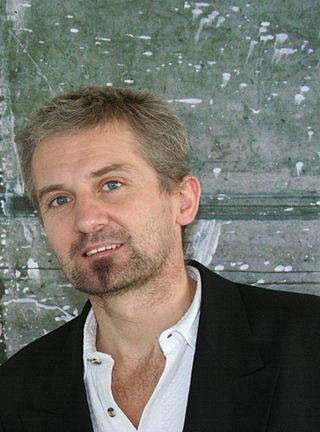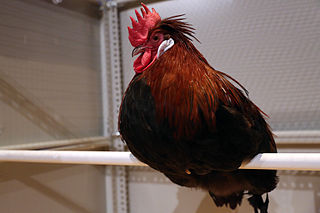
The Stedelijk Museum voor Actuele Kunst is a relatively new museum located in Ghent, Belgium, and is renowned both for its permanent collection and for its provocative exhibitions.
Jan De Cock is a contemporary Belgian visual artist. From the start of his career, his art has revolved around production and the ways in which an artist relates to the broad culturally-injected concept of Modernism. In 2003 Jan De Cock entered the competition Prix de la Jeune Peinture Belge. He is, after Luc Tuymans, only the second Belgian artist to have had a solo exposition at Tate Modern and the first living Belgian artist to have an exhibition at MoMA, which opened on 23 January 2008. Much of his work draws on visual and formal comparisons between early-20th century abstract art movements and contemporary design and mass production. During the first decade of his career the artist worked on the intersection of sculpture and architecture and he succeeded in extending the underlying functionalist consequences of the Russian Modernist artist El Lissitzky‘s Proun Room, thus completing a missing link within the modernist program yet to be completed in late twentieth century modernist art.

Michaël Borremans is a Belgian painter and filmmaker who lives and works in Ghent. His painting technique draws on 18th-century art, as well as the works of Édouard Manet and Degas. The artist also cites the Spanish court painter Diego Velázquez as an important influence. In recent years, he has been using photographs he has made himself or made-to-order sculptures as the basis for his paintings.

Guillaume Bijl is a Belgian conceptual and an installation artist. He lives and works in Antwerp.
Mark Manders is a Dutch artist, currently living and working in Ronse, Belgium. His work consists mainly of installations, drawings and sculptures. He is probably best known for his large bronze figures that look like rough-hewn, wet or peeling clay. Typical of his work is also the arrangement of random objects, such as tables, chairs, light bulbs, blankets and dead animals.

Manfred "KILI" Kielnhofer is an Austrian painter, sculptor, designer and photographer. Due to his antisemitic statements in connection with the planned vaccination to contain the COVID-19 pandemic, numerous of his works of art were removed from public space.

Gabriel Lester is an inventor, visual artist and film director living and working in Amsterdam.
Hans Vandekerckhove is a Belgian painter, living and working in Ghent. From 1975 to 1997 Vandekerckhove studied Art History at University Ghent, where he wrote his graduation thesis on David Hockney.
Glasstress is a recurring exhibition that brings together art by contemporary artists made with glass. Launched in 2009 as a collateral exhibition of the Venice Biennale of Arts by Adriano Berengo as a way of showcasing the works produced by Berengo Studio, it has since had editions take place in 2011, 2013, 2015, 2017, 2019, 2021 and 2022.
Berengo Studio is a glass studio transforming the art of glass and glass art through collaborations with contemporary artists based in Murano, Venice, Italy.

Peter Noever is an Austrian designer and curator–at–large of art, architecture and media. From 1986 to 2011 he was the artistic director and CEO of MAK—Austrian Museum of Applied Arts and Contemporary Art in Vienna.

Oksana Mas is a Ukrainian contemporary artist and the organizer of "ArtTogether", a global interactive art project aimed at visualizing the new cultural code of the modern generation and uniting people at a time of political and social turmoil.
Charlotte Hodes, is a British artist.

The Guardians of Time is an art project of the Austrian sculptor Manfred Kielnhofer.

BiennaleOnline is an online exhibition of contemporary art. The exhibition aims to focus on the most promising emerging visual artists worldwide, presenting works in New Media, Installation, Traditional Media, Photography and Performance. These artists will come from Europe, North America, South America, Asia, and the Middle East, and have been selected by 29 leading international curators.

The Cosmopolitan Chicken Project is a global, transdisciplinary and transtemporal examination of the themes of biocultural diversity and identity through the interplay of art, science and beauty. In the CCP Koen Vanmechelen cross-breeds chicken breeds from different countries. His ultimate goal is the creation of a Cosmopolitan Chicken carrying the genes of all the planet's chicken breeds. Much more than a mere domesticated animal, the chicken is art in itself.
Koen van den Broek is a Belgian artist who lives and works in Antwerp and Seoul, South Korea.

Alicia Framis is a contemporary artist living and working in Amsterdam, Netherlands. She develops platforms for creative social interaction, often through interdisciplinary collaboration with other artists and specialists across various fields. Her work is project based and focuses on different aspects of human existence within contemporary urban society. Framis often starts out from actual social dilemmas to develop novel settings and proposed solutions. Framis studied with the French minimalist artist Daniel Buren and the American conceptual artist Dan Graham and her work can be located within the lineages of relational aesthetics, performance art, and social practice art. She represented the Netherlands in the Dutch Pavilion at the 50th Venice Biennale (2003). She is currently the director of an MA program at the Sandberg Instituut in Amsterdam, Netherlands and a lecturer at Nebrija University in Madrid, Spain. In 2019, Alicia Framis was awarded with the Lucas Artists Visual Arts Fellowship 2019-2022 in California.
Ricardo Rodríguez Brey is a Cuban conceptual artist, sculptor, installation artist and draftsman.

The Belgian pavilion houses Belgium's national representation during the Venice Biennale arts festivals.












